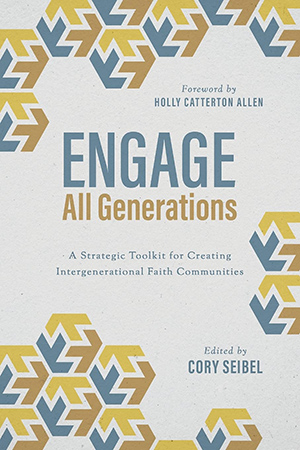Book Review: Engage All Generations: A Strategic Toolkit for Creating Intergenerational Faith Communities

Engage All Generations: A Strategic Toolkit for Creating Intergenerational Faith Communities Edited by Cory Seibel. Abilene Christian University Press: Abilene, TX. 2021. Total pages: 239.
In the past few decades, leaders in youth ministry have seen their target group enlarge to include two age segments: youth (teens) and young adults (post-high school or 20-somethings). Those in children’s ministry rarely receive professional status even though all people get shaped profoundly during this stage (or stages) of life. But the new perspective of an Intergenerational Church harkens back to pre-Industrial Revolution times (about the beginning of the United States as an independent country). This resurgence, fueled largely by leaders in children’s ministry and youth ministry, aims to include all generations mutually interacting for the purpose of spiritual growth and community/fellowship.
The term “Intergenerational Church” might be new to some, but it continues to permeate churches and organizations. The first “InterGenerate Conference” met in the Spring of 2017, followed by a second bi-annual gathering in 2019. Engage All Generations contains a collection of the general sessions and the breakout workshops from this second “InterGenerate Conference.” I attended that conference and found the book to be more succinct than the oral presentations. Of course, meeting in person allows for more interaction, bridge-building, and cross-fertilization.
Editor Cory Seibel arranged the chapters into three groupings. The first section, “Learning and Growing Together,” describes intergenerational ministry including theoretical and theological foundations such as Deuteronomy passages, the significance of Sabbath, faith formation and discipleship models, and even play. The second, “Praying and Playing Together,” illustrates a variety of spiritual practices to include all generations as well as playful activities that impact spirituality—not revolutionary for children’s ministry or youth ministry, but putting it out there for adults who might have difficulty seeing the connection. The third section, “Leading and Changing Together,” addresses the challenge of bringing about change for something like increased intergenerational practices and priorities in congregations.
As with any edited book, some chapters will resonate with certain readers more than others. Valerie Grissom’s chapter on ISPs (Intergenerational Scripture Presentation) described her experience of investing in the Scripture Reading portion of the worship service. Instead of one person reading a verse or passage, a group of various ages come together and brainstorm the “presentation” which might involve media, participation, drama, color, motions, and music. The preparation for the ISP is yet one more opportunity for intergenerational faith formation in addition to the actual presentation to the congregation as a whole.
Chris Barnett, a church leader from Australia, shared tools to increase understanding the term “intergenerational” which can be helpful when terms are new or lack clarity. One of these tools illustrates four different terms to contrast and refine a definition for “intergenerational.” Each of these proves to be self-descriptive.
Mono-Generational is indeed only one generation. Think of youth church or children’s church. Some have started a young adult church. Many smaller churches don’t intend to be mono-generational, but only senior citizens attend—which makes it mono-generational by default. To experience this in a matter of minutes, Barnett suggests dividing a group into four random subgroups and each group forms separate huddles, oblivious to those in the other groups, as each group discusses any topic, such as how your family celebrates birthdays. Call time and point out this illustrates a mono-generational church—fine in its own setting, but blind to anyone or anything else.
Cross-Generational has two generations, but one generation (often the older one) shapes or dictates to the other generation through one-way communication. The dominant group acts superior and passes on its reservoir to the inferior group. Illustrate this by sending one person from one of the previous groups to go explain to another group what they heard about birthday celebrations in the previous exercise. Make it one-way communication so the rest of the group listens while the visitor shares the wisdom they gleaned from their first group rather than hearing anything from the group to which they inform.
Multi-Generational often prides itself on having multiple generations present, but each generation operates in its own sphere with little interaction or mutuality between the generations. Often large, multi-staff churches operate in this fashion, with a youth pastor, a young adult pastor, and maybe even a children’s pastor. Some add a “visitation pastor” to visit the retired church members (senior citizen pastor, but they won’t use that label). These churches often consider themselves to be “intergenerational” simply because multiple generations can be spotted. But you’ll see with the next definition that they don’t qualify. Illustrate this by having each group stay as separate groups and turn to the other groups to smile, wave, and nod in an affirming manner, without truly interacting with other groups in any significant or meaningful way.
Inter-Generational involves mutuality, sharing, equality, and spiritual growth for all ages, even when this necessitates intentionality. Some small churches do this simply because their size demands it. The larger the church, the more likely it will segregate rather than include all. It can be messy, but all ages benefit when all ages share. Including all reminds one of Paul’s analogy that the church is the Body of Christ, which includes all ages. Illustrate this by sending one person from each group to form new groups that share what each group discussed about their topic (how you family celebrates birthdays). Be sure each person in the interspersed groups get an opportunity to share.
Many churches already practice intergenerational experiences. Churches that make this the norm rather than the exception gain the greatest benefit. But don’t expect those accustomed to something else to immediately embrace this.
Engage All Generations provides a helpful tool to understand, adjust, and change churches toward greater faith formation through intergenerational attitudes, activities, and actions. This book can aid your understanding and enable you to foster greater faith formation in congregations when you “engage all generations.”
 |
Steve Case, PhD, serves as the coordinator for the Intergenerational Church concentration in the Andrews University Doctor of Ministry program. |
